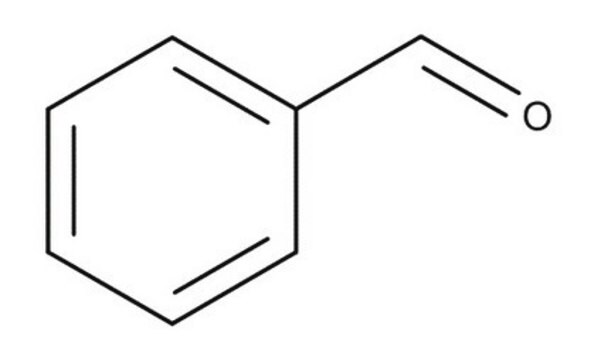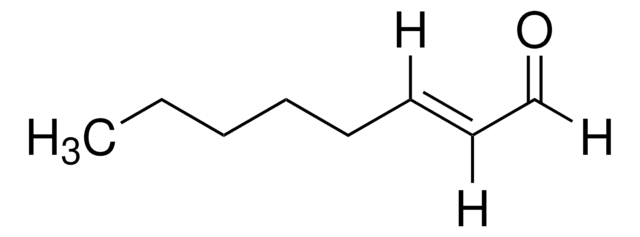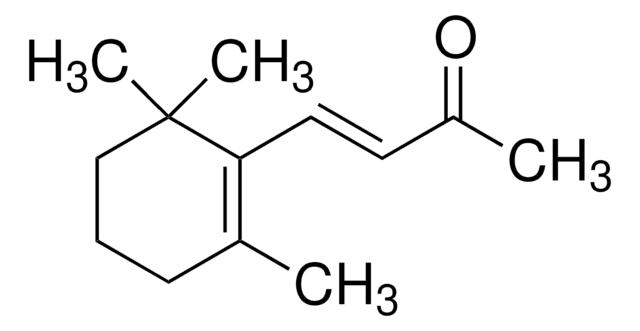W212709
Benzaldehyde
≥98%, FG, FCC
Sinónimos:
Bitter almond
About This Item
Productos recomendados
origen biológico
synthetic
Nivel de calidad
grado
FG
Halal
Kosher
Agency
meets purity specifications of JECFA
cumplimiento norm.
EU Regulation 1334/2008 & 178/2002
FCC
FDA 21 CFR 117
FDA 21 CFR 182.60
densidad de vapor
3.65 (vs air)
3.7 (vs air)
presión de vapor
4 mmHg ( 45 °C)
Análisis
≥98%
formulario
liquid
temp. de autoignición
374 °F
lim. expl.
1.4 %, 20 °F
índice de refracción
n20/D 1.545 (lit.)
pH
5.9 (20 °C)
bp
178-179 °C (lit.)
mp
−26 °C (lit.)
densidad
1.044 g/cm3 at 20 °C (lit.)
aplicaciones
flavors and fragrances
Documentación
see Safety & Documentation for available documents
alérgeno alimentario
no known allergens
Organoléptico
almond; cherry; sweet
cadena SMILES
O=Cc1ccccc1
InChI
1S/C7H6O/c8-6-7-4-2-1-3-5-7/h1-6H
Clave InChI
HUMNYLRZRPPJDN-UHFFFAOYSA-N
¿Está buscando productos similares? Visita Guía de comparación de productos
Descripción general
Aplicación
- Volatolomics-assisted characterization of the key odorants in green off-flavor black tea and their dynamic changes during processing.: This study highlights the role of Benzaldehyde in identifying and characterizing key odorants in green off-flavor black tea, using advanced volatolomics techniques. This research provides essential insights into flavor science and the impact of processing methods on tea quality (Yang et al., 2024).
- Volatilome and flavor analyses based on e-nose combined with HS-GC-MS provide new insights into ploidy germplasm diversity in Platostoma palustre.: This research uses Benzaldehyde as a standard in electronic nose and gas chromatography-mass spectrometry analyses to explore plant volatilomes, significantly contributing to our understanding of plant biochemistry and genetic diversity (Zhong et al., 2024).
Palabra de señalización
Danger
Frases de peligro
Clasificaciones de peligro
Acute Tox. 4 Inhalation - Acute Tox. 4 Oral - Aquatic Chronic 2 - Eye Irrit. 2 - Repr. 1B - Skin Irrit. 2 - STOT SE 3
Órganos de actuación
Respiratory system
Código de clase de almacenamiento
6.1C - Combustible acute toxic Cat.3 / toxic compounds or compounds which causing chronic effects
Clase de riesgo para el agua (WGK)
WGK 1
Punto de inflamabilidad (°F)
145.4 °F - closed cup
Punto de inflamabilidad (°C)
63 °C - closed cup
Equipo de protección personal
Eyeshields, Faceshields, Gloves, type ABEK (EN14387) respirator filter
Certificados de análisis (COA)
Busque Certificados de análisis (COA) introduciendo el número de lote del producto. Los números de lote se encuentran en la etiqueta del producto después de las palabras «Lot» o «Batch»
¿Ya tiene este producto?
Encuentre la documentación para los productos que ha comprado recientemente en la Biblioteca de documentos.
Nuestro equipo de científicos tiene experiencia en todas las áreas de investigación: Ciencias de la vida, Ciencia de los materiales, Síntesis química, Cromatografía, Analítica y muchas otras.
Póngase en contacto con el Servicio técnico








